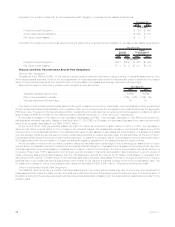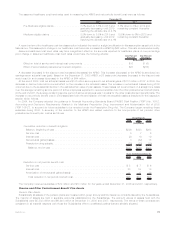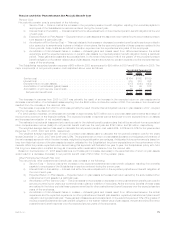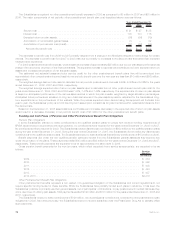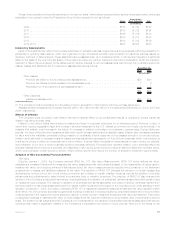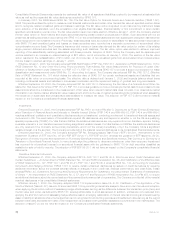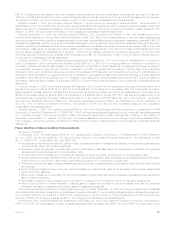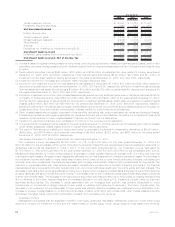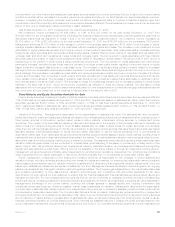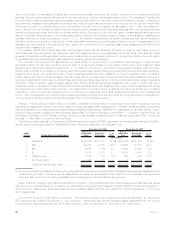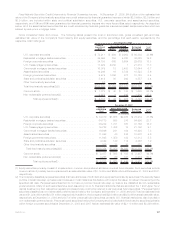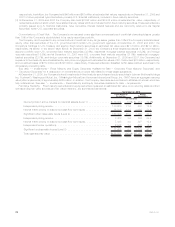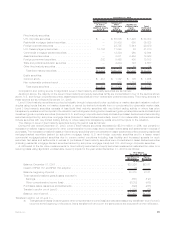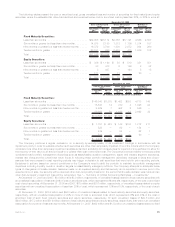MetLife 2008 Annual Report Download - page 84
Download and view the complete annual report
Please find page 84 of the 2008 MetLife annual report below. You can navigate through the pages in the report by either clicking on the pages listed below, or by using the keyword search tool below to find specific information within the annual report.FSP 13-2 requires that the change in the net investment balance resulting from the recalculation be recognized as a gain or loss from
continuing operations in the same line item in which leveraged lease income is recognized in the year in which the assumption is changed.
The adoption of FSP 13-2 did not have a material impact on the Company’s consolidated financial statements.
Effective January 1, 2007, the Company adopted SFAS No. 156, Accounting for Servicing of Financial Assets — an amendment of
FASB Statement No. 140 (“SFAS 156”). Among other requirements, SFAS 156 requires an entity to recognize a servicing asset or servicing
liability each time it undertakes an obligation to service a financial asset by entering into a servicing contract in certain situations. The
adoption of SFAS 156 did not have an impact on the Company’s consolidated financial statements.
Effective November 15, 2006, the Company adopted SAB No. 108, Considering the Effects of Prior Year Misstatements when
Quantifying Misstatements in Current Year Financial Statements (“SAB 108”). SAB 108 provides guidance on how prior year misstatements
should be considered when quantifying misstatements in current year financial statements for purposes of assessing materiality. SAB 108
requires that registrants quantify errors using both a balance sheet and income statement approach and evaluate whether either approach
results in quantifying a misstatement that, when relevant quantitative and qualitative factors are considered, is material. SAB 108 permits
companies to initially apply its provisions by either restating prior financial statements or recording a cumulative effect adjustment to the
carrying values of assets and liabilities as of January 1, 2006 with an offsetting adjustment to retained earnings for errors that were
previously deemed immaterial but are material under the guidance in SAB 108. The adoption of SAB 108 did not have a material impact on
the Company’s consolidated financial statements.
Effective January 1, 2006, the Company adopted prospectively EITF Issue No. 05-7, Accounting for Modifications to Conversion
Options Embedded in Debt Instruments and Related Issues (“EITF 05-7”). EITF 05-7 provides guidance on whether a modification of
conversion options embedded in debt results in an extinguishment of that debt. In certain situations, companies may change the terms of
an embedded conversion option as part of a debt modification. The EITF concluded that the change in the fair value of an embedded
conversion option upon modification should be included in the analysis of EITF Issue No. 96-19, Debtor’s Accounting for a Modification or
Exchange of Debt Instruments, to determine whether a modification or extinguishment has occurred and that a change in the fair value of a
conversion option should be recognized upon the modification as a discount (or premium) associated with the debt, and an increase (or
decrease) in additional paid-in capital. The adoption of EITF 05-7 did not have a material impact on the Company’s consolidated financial
statements.
Effective January 1, 2006, the Company adopted EITF Issue No. 05-8, Income Tax Consequences of Issuing Convertible Debt with a
Beneficial Conversion Feature (“EITF 05-8”). EITF 05-8 concludes that: (i) the issuance of convertible debt with a beneficial conversion
feature results in a basis difference that should be accounted for as a temporary difference; and (ii) the establishment of the deferred tax
liability for the basis difference should result in an adjustment to additional paid-in capital. EITF 05-8 was applied retrospectively for all
instruments with a beneficial conversion feature accounted for in accordance with EITF Issue No. 98-5, Accounting for Convertible
Securities with Beneficial Conversion Features or Contingently Adjustable Conversion Ratios, and EITF Issue No. 00-27, Application of
Issue No. 98-5 to Certain Convertible Instruments. The adoption of EITF 05-8 did not have a material impact on the Company’s
consolidated financial statements.
Effective January 1, 2006, the Company adopted SFAS No. 154, Accounting Changes and Error Corrections, a replacement of APB
Opinion No. 20 and FASB Statement No. 3 (“SFAS 154”). SFAS 154 requires retrospective application to prior periods’ financial statements
for a voluntary change in accounting principle unless it is deemed impracticable. It also requires that a change in the method of
depreciation, amortization, or depletion for long-lived, non-financial assets be accounted for as a change in accounting estimate rather
than a change in accounting principle. The adoption of SFAS 154 did not have a material impact on the Company’s consolidated financial
statements.
Future Adoption of New Accounting Pronouncements
Business Combinations
In December 2007, the FASB issued SFAS No. 141 (revised 2007), Business Combinations — A Replacement of FASB Statement
No. 141 (“SFAS 141(r)”) and SFAS No. 160, Noncontrolling Interests in Consolidated Financial Statements — An Amendment of ARB
No. 51 (“SFAS 160”). Under SFAS 141(r) and SFAS 160:
• All business combinations (whether full, partial or “step” acquisitions) result in all assets and liabilities of an acquired business being
recorded at fair value, with limited exceptions.
• Acquisition costs are generally expensed as incurred; restructuring costs associated with a business combination are generally
expensed as incurred subsequent to the acquisition date.
• The fair value of the purchase price, including the issuance of equity securities, is determined on the acquisition date.
• Certain acquired contingent liabilities are recorded at fair value at the acquisition date and subsequently measured at either the higher
of such amount or the amount determined under existing guidance for non-acquired contingencies.
• Changes in deferred tax asset valuation allowances and income tax uncertainties after the acquisition date generally affect income
tax expense.
• Noncontrolling interests (formerly known as “minority interests”) are valued at fair value at the acquisition date and are presented as
equity rather than liabilities.
• When control is attained on previously noncontrolling interests, the previously held equity interests are remeasured at fair value and a
gain or loss is recognized.
• Purchases or sales of equity interests that do not result in a change in control are accounted for as equity transactions.
• When control is lost in a partial disposition, realized gains or losses are recorded on equity ownership sold and the remaining
ownership interest is remeasured and holding gains or losses are recognized.
The pronouncements are effective for fiscal years beginning on or after December 15, 2008 and apply prospectively to business
combinations after that date. Presentation and disclosure requirements related to noncontrolling interests must be retrospectively applied.
The Company will apply the guidance in SFAS 141(r) prospectively on its accounting for future acquisitions and does not expect the
adoption of SFAS 160 to have a material impact on the Company’s consolidated financial statements.
In November 2008, the FASB ratified the consensus on EITF Issue No. 08-6, Equity Method Investment Accounting Considerations
(“EITF 08-6”). EITF 08-6 addresses a number of issues associated with the impact that SFAS 141(r) and SFAS 160 might have on the
81MetLife, Inc.



